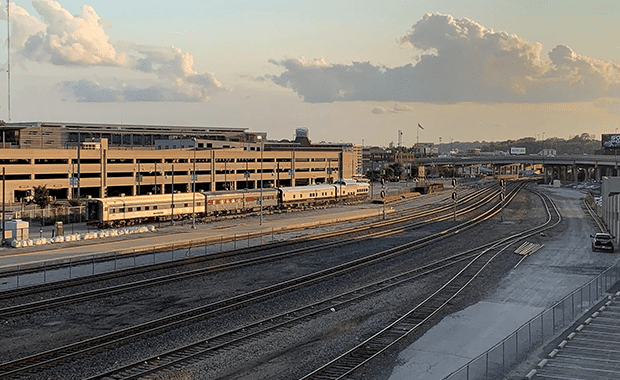GK Adviser and former chairman of the FCA, John Griffith-Jones shares his thoughts of the three key challenges for the financial services sector.
Download the report here: The good, the bad and the ugly

GK Adviser and former chairman of the FCA, John Griffith-Jones shares his thoughts of the three key challenges for the financial services sector.
Download the report here: The good, the bad and the ugly

Sir Peter Hendy’s interim Union Connectivity review was published today (10th March). The Review was launched in October 2020 to consider transport connectivity across the United Kingdom and to identify a series of recommendations that will support the Government’s strategic ambitions. Hendy’s final recommendations are expected in the Summer.
Despite being an independent review, the highly political mandate from Government is evident even in this initial iteration. From ‘levelling up’ to the environmental agenda and the future of the Union, the Review is shaping up to be the latest in a long line of reports which elucidate the Johnson administration’s post-COVID, post-Brexit vision for the UK. Hendy appears highly conscious of his work’s position in the greater scheme of things – citing the recent Integrated Rail Plan, the Regional Air Connectivity Review and the upcoming Transport Decarbonisation Plan as parallel and interdependent pieces of work.
As the name suggests, where the Union Connectivity Review is most additive is on the question of how transport links could better operate between nations of the UK. The headline proposal is for a new ‘pan-UK’ strategic transport network to work alongside the existing strategic networks of each nation. This would not alter the operational responsibilities of Highways England, Transport Scotland and others, but would complement them with cross border strategies and assessments.
The final Review will provide an assessment of the ongoing costs of such a network, including preliminary costing and timescales for the proposed fixed link between the British mainland and Northern Ireland.
Only at subsequent budgetary events – most notably the anticipated 2021 Spending Review – will we see how the Government’s priorities fall between cross-border connectivity and other transport projects, including the flagship HS2 project. From a political perspective a Conservative government might assess that apart from diluting the pro-independence feeling in Scotland, there is more to be gained from shoring up their voter-base in the Midlands and the North, than from creating better cross-border links.
On top of the political considerations, there is growing talk of unease from the Treasury about the level of investment chalked up for transport projects versus digital infrastructure – the so-called ‘steel versus fibre’ debate. This rift is one reason given for the continued delay to DfT’s publication of the Rail Network Enhancements Pipeline, which is hotly anticipated by the sector.
If these strands of thought prevail, a new pan-UK strategic transport network could end up far more strategy than substance.

The second week of February was National Apprenticeship Week, and providers, employers and assessors of apprentices waited with bated breath for the plethora of announcements that would come thick and fast to support the sector and encourage greater uptake of apprenticeships by employers. They were disappointed.
Last month’s celebration of the Government’s flagship training and employment policy was a muted affair, with the DfE concentrating on awareness-raising and success stories rather than solid policies. This happened despite the broad consensus currently shared between policymakers and businesses that apprenticeships can provide a solution to a number of issues created or exacerbated by the pandemic. For instance, they can assist in reducing youth unemployment, and allow businesses to meet the new needs of the economy post-pandemic, by retraining existing staff.
Of course, over the past 12 months, the Government has been tinkering with its apprenticeships policy. Most notably with the introduction of the “opportunity guarantee” in June of last year, in which the Prime Minister promised that every young person who wanted an apprenticeship should get one. This featured a cash handout to employers for every apprentice under 25 that they hire. However, this was widely seen at the time as being not nearly enough to offset the risk employers would be taking on by hiring new staff in such an uncertain time. More broadly, this policy has been accompanied by several other announcements in related areas – kickstart, traineeships, t-levels, vocational training – a veritable scattergun of ideas.
This was crystalised with the Spending Review at the end of last year, and the Skills for Jobs White Paper, announced in January, which proposed a number of structural changes to apprenticeships and other similar policies to make them more flexible for employer needs.
While it is good to see the Government prioritising this area, the lack of focus on any one scheme (of which apprenticeships is the most promising) risks confusing and diluting the impact of their initiatives. Apprenticeships work best when they are part of a pathway from education to employment, bridging the gap from school leavers to full-time employees, with a ramp on and off to ensure individuals are not left out from the next stage of their development.
Apprenticeships are fortunate to have some effective advocates both within Parliament and the sector – and it is time for the Government to work more closely with those who want to utilise apprenticeships, and to remove the stumbling blocks that COVID has put in their way. Training providers and employers of apprentices now have an opportunity to engage constructively in this conversation, and stand to reap the rewards of well-trained, motivated staff while Britain builds back better.